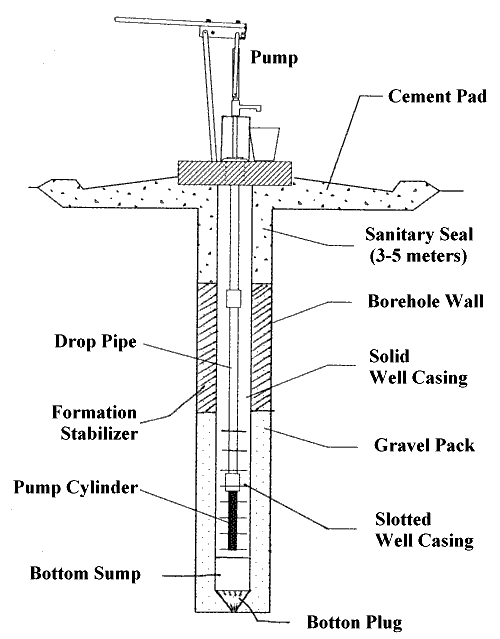
Section 9
Sanitary Grout SealAfter the filter pack is placed, there is still an irregularly shaped annular space around the casing. In caving material such as sand or sand and gravel, the annular space is often quickly filled by caving material. However, where the material overlying the water-bearing formation is firm sand, clay, shale etc. and the borehole does not cave-in, the annular space must be filled.
| A formation seal (cement grout) is placed into the annular space to prevent the seepage of contaminated surface water down along the outside of the casing into the well. General instructions on how to place grout seals are provided below and more detailed directions are available (see Appendix [). |
If cement is scarce or extremely expensive, the annular space above the filter pack can be filled to within 3 - 6 metres (10 - 20 feet) of surface with a formation stabilizer consisting of clean, washed sand or drill cuttings (see Figure 15). Wherever possible, it is best to avoid using a formation stabilizer and place a formation seal directly above the filter pack. Formation stabilizer should not be used in wells constructed in rock that is overlain by relatively thin, loosely consolidated sediment; they should be grouted from the ground surface to the rock.
Fill the top 3 - 6 m (10 - 20 ft) of annular space with a formation seal that extends up to ground level (see Figure 15). The sealant may be cement grout, bentonite (clay) or concrete. Commonly used conversion tables are available to help you calculate the required volume (see Appendix B). The formation seal must be effectively placed to prevent contaminated surface run-off from infiltrating into the well.
| Concrete is normally used as the formation seal; mix it using a ratio of 2:3:0 - 2 parts cement: 3 parts sand: 0 parts gravel. If grout is to be poured into the hole through a small grout (tremie) line (Appendix I), mix the grout to the consistency of a thick cream (4 volumes cement powder + 3 volumes water = 5 volumes grout slurry (Australian, 1992). |
While gravel is normally used in making concrete, the annular space (between the casing the and borehole wall) is so small that just getting a thin grout down the hole is hard; adding gravel to the mix would make it much more difficult.
Keep the concrete mix as dry as possible since increasing the amount of water will increase the amount of subsequent shrinkage and increase the chance of contaminants entering the well!
Figure 15: Completed Well Details

There is no significant penetration by cement into uniform sand with grain size finer than 0.6 mm (0.025 in). Therefore, if grouting on top of a filter pack, ensure that 1 metre (3 feet) of fine sand is first placed on the filter pack to avoid plugging it with grout. If available, it is even better to pour 0.3 - 1.0 metres of bentonite on top of the filter pack before the cement seal is poured. If this is done, the bentonite will swell and force it and the cement into the formation creating one of the best seals you can have in a well.
If cement is unavailable, the casing be sealed by pouring just bentonite down the hole. The bentonite should be mixed at concentrations of 0.7 kg (1.5 lb) bentonite per 3.8 l (1 gal) of water (Driscoll, 1986). Pour it soon after mixing so that it hydrates (absorbs water and swells) in the ground, thus creating a tight seal. Although this concentration it too thick to be pumped, it will not shrink provided the ground around the grout remains somewhat moist.
When heavily contaminated soil or a severely polluted surficial aquifer are encountered, well casing should be securely grouted into an underlying rock or clay layer. This can be done using the "Modified Halliburton Wiper Plug Method", a technique which can also be used to seal casing into rock when switching from mud rotary to air hammer drilling (see Appendix I). If you need to backfill part of the borehole prior to setting a casing, consider using the Cement "Plastic Bag Plug" Method (Appendix I).
Finally, once casing is grouted in-place, mound soil around the well and grade it away from the well. This will prevent poor quality surface water from ponding near the well and entering the well through the annulus (between the well casing and the borehole) if the grout seal is not perfect.
References
Australian Drilling Industry Training Committee Ltd (1992) Australian Drilling Manual 3rd edition", Macquarie Centre: Australian Drilling Industry Training Committee Ltd, ISBN 0-949279-20X.
Driscoll, F. (1986) Groundwater and Wells, St. Paul: Johnson Division